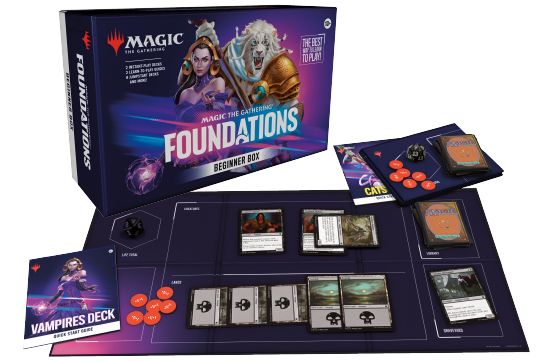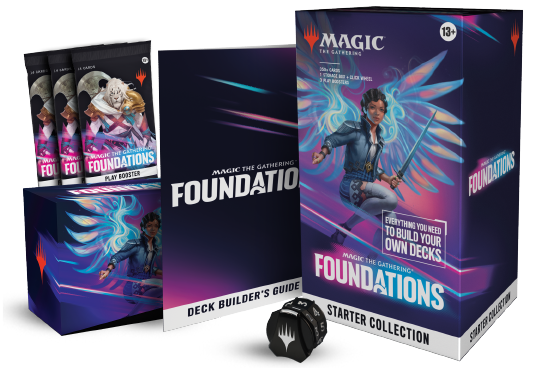Wizards of the Coast’s latest Magic: The Gathering set, Foundations, has arrived and brings with it a raft of changes. Designed to provide a solid basis for the standard constructed playing environment for the next 5 years, Foundations is the latest evolution on the concept of core sets.
Before I dive into the set’s contents, I’d like to provide some context around why this set is different from your average MTG expansion.
Standard Changes
In the last few years, WOTC has noted that despite the booming popularity of Commander and constructed environments like Pioneer and Modern, Standard has been struggling by comparison. This has probably set off a few alarm bells because the Standard constructed environment is a key driver of sales for Magic: The Gathering.
A rotating format historically comprised of 2 years’ worth of the most recent MTG expansions, Standard requires players to keep purchasing new cards to maintain competitive decks. So if Standard play drys up, revenues fall for WOTC. In May 2023 an article posted on the primary Magic website highlighted the issue and discussed plans for revitalising Standard. Step 1 of the plan was also announced: extending the set rotation out of standard from 2 years to 3 years.
The next step announced in September 2023 was ramping up the schedule for standard events, from local stores that are part of the Wizards Play Network, all the way through to the Pro Tour; along with plenty of prize support. Just last month (October 2024) another fundamental shift occurred. First, the set release roster for 2025 was published:

The final set marked UUB stands for Unannounced Universes Beyond. So the set roster for next year is split half-and-half. Three sets are designated Universes Within, or themed around existing MTG intellectual property; and the other three are based on external IPs: Final Fantasy, Spiderman, and one as yet unannounced.
The second announcement shocked a lot of people. Aaron Forsythe, Vice President of Magic Design released an article announcing Universes Beyond sets printed from 2025 onwards would be legal in all formats (rather than just the Modern Format).
This was contrary to previous advice, published alongside WOTC’s first forays into Universes Beyond, that “Universes Beyond cards will not be Standard legal. We strive to make Magic cards that are widely useful, but Universes Beyond will be above and, well, beyond our normal Standard releases.”
There has been a lot of angst on social media about this change. But looking at things from WOTC’s perspective, it makes sense – Lord of the Rings is now their best-selling product of all time, and Universes Beyond sets tap into player markets well beyond the normal reach of the product.
Rocked to the core
So how does Foundations fit into the big picture? To answer that, we need to take a closer look at the history of Core sets.
Core (or basic, as previously known) sets have been part of Magic’s DNA since its inception. Basic sets following the original Alpha and Beta “limited” sets were printed roughly every two years, maintaining a consistent set of staples while re-introducing a raft of previously printed cards back into the standard environment.
Some changes occurred to core sets starting with Magic 2010 (M10). To spice up the product and help drive sales to existing players, core sets pivoted from reprints only to a mixture of reprinted and new cards. Reading between the lines, it seems apparent that while this change drove some increased sales, core sets continued to perform worse than expansion sets, and the product line was put on hiatus following the release of Magic Origins.
“New art and frames can be pretty strong draws for players looking to ‘bling’ up their decks’…”
However, it was soon realised that core sets provided some much-needed functions. A 2017 article from Magic The Gathering head designer Mark Rosewater highlighted some of the issues raised by removing core sets from the lineup:
- Core sets allowed reprints of cards into the standard environment, where the names, mechanics or creature types may not fit with the current sets in production.
- Core sets allowed the introduction of new 1-off cards to support themes deck archetypes from previously printed sets.
- Removing core sets led to reduced opportunities to support new players and teach them how to play.
- Core set helped with product fatigue by giving players a product they could skip.
Mark used the article to announce the re-introduction of core sets back into WOTC’s product lineup. This revival brought with it a renewed focus on introducing new players to the MTG hobby. But it proved short-lived, and after Magic Core set 2021, the product line was discontinued once more.
A New Foundation
That, more or less, brings us back to the present day and the new approach being trialled by WOTC. As mentioned earlier, Foundations has been announced as an ‘evergreen’ set designed to provide a solid basis for the standard constructed playing environment for the next five years – well beyond the previous print runs of one to two years. So the question on many people’s minds is “What makes this set different to previous core sets”?
There are a few factors to consider there. One is that the core set product line was last dropped around about the same time as the introduction of “booster fun”; extended art and borderless cards, new ‘showcase’ frames, and different foil treatments; all of which lend a new spin on collectability.
New art and frames can be pretty strong draws for players looking to ‘bling’ up their decks’, even if the cards are reprints of cards the player already owns. There is plenty on show in Foundations:

The major draw here is the new Japanese anime art showcase cards, in various foiling effects including the fractured foil look. Card prices are intrinsically linked to scarcity, with cards like the new Bloodthirsty Conquerer currently selling for hundreds of dollars:
On a personal level, I’m… not a fan. There is so much going on in the art, and the fractured foiling effect just adds to the chaos. Combining that with the minimalist text and framing, the card is hard to read. But maybe that’s just my old-timer perspective; obviously, there are plenty of people who love them and are willing to pay exorbitant prices to own them. The fact that they are designed aesthetically to bring to mind other popular TCG formatting probably also increases the draw for people.
Booster fun isn’t the only factor at play here. After all, Core Set 2021 (M21) featured these card effects for the first time in a core set product, and that didn’t do enough to keep them from being discontinued.
New Player support
I mentioned earlier in the article that part of the need for core sets stems from having a product designed to introduce new players to the game. In some ways, it feels odd to consider Foundations a new player product because there is a significant amount of complexity in it. Mark Rosewater again talks about how their internal testing and focus groups helped them see that simplicity isn’t always the best objective for newer players; “One of the most important questions we ask focus groups is “Would you like to play more Magic?” followed by “Why?” On this particular day of testing, we got a bunch of “no” replies. When we asked why, they said the game was too boring. There just wasn’t enough to it. It lacked depth.”
As a result of the focus group’s feedback, WOTC changed the design focus from streamlining and simplifying cards in the set to embracing the complexity of Magic. Instead, they focused on “coolness”; by using popular themes and card types, and using artwork, card names and flavour text to reference all the ‘Universes Within’ planes currently in the standard environment.
There are still products designed to support new players though. Like the Beginner Box, which contains playmats, a walkthrough first game for 2 players, and 10 boosters in various themes and colours, designed to play in a similar style to Jumpstart where a player can grab 2 boosters, shuffle the contents together, and play a game.

There is also the Starter Collection, which, in addition to 3 boosters to introduce new players to the gambling dopamine hit of opening boosters, contains 350+ pre-determined cards that can provide an effective kickstart card base for new players to start designing decks and get into the hobby.

My Take
My personal experience with Foundations so far has been good. I played a casual prerelease-sealed event with a few other players. My deck ended up in G/W, which has surprisingly effective removal. I got the win, mostly through my two opponents picking away at each other and not paying enough attention to me. While I was by far the most experienced player of the three, they still managed to competently build decks within a short timeframe, showing that Foundations is relatively easy to get into for varying skill levels.
Here are some of the cards that made an impact on our game:
Final Thoughts
How are things going to play out this time around for the latest evolution of Core sets? Signs so far point towards Foundations being a success. The vibe on social media towards the set has been largely positive, with anecdotal accounts of excellent sales at local game stores over the last week or two. What this means for the product line in the future is yet to be seen.
The small amount of discontent I’ve seen has been levelled more at Play Boosters than Foundations as a set; specifically, the fact that they are less well-designed for limited environments than the old Draft Boosters. Some players get plenty of bombs in a specific colour without much support in the commons and uncommons.
Overall, Foundations seems pretty solid, especially if you’re interested in diving into the behemoth of Magic: The Gathering for the first time.
Magic: The Gathering Foundations is available in stores now.
Checkpoint Gaming was provided with a generous Magic: The Gathering Foundations press kit to assist with coverage.











